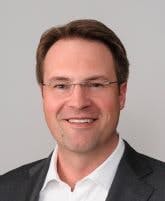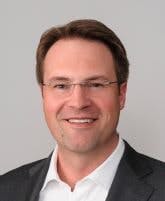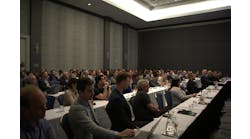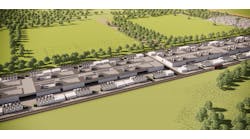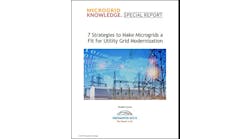Microgrids are among the disruptive class of tech, that which challenges the status quo to improve society. However, lately a technology’s worth is based less on how well it disrupts and more on how well it responds to societal disruption.
With the disruption brought by COVID-19, products like teleconferencing, home delivery and telemedicine appear to be emerging as winners. So too are microgrids, as became apparent last week as more than 4,000 people joined our virtual conference — the largest gathering ever of those interested in microgrids. They came to understand — and help chart — a course for microgrids in this new era.
Erik Svanholm, S&C Electric
More than 50 energy leaders offered their take on the role of microgrids as society rethinks the old way of doing things — and where it really can’t lose power. Here are three key messages we took away.
Supply chains are thin. Flexibility is crucial
The pandemic reminded us that it’s impossible to prepare for every contingency, noted Erik Svanholm, vice president of non-wires alternatives at S&C Electric. “Flexibility and ability to quickly adjust are crucial.”
And that’s what microgrids offer with their multiple energy assets and intelligence that allows them to quickly shift what combination of solar, storage, generators, grid assets or other resources are best to employ at any given time based on grid reliability, weather, pricing and other metrics. This is something mere backup generators cannot do.
“For energy resiliency a backup generator solves a single issue a single way, has its own supply chain and inserts a new point of failure,” he said. “The best bet is to have flexible systems with multiple operational modes and pathways that have a better chance of exhibiting a useful operating mode regardless of what actually happens out there. For microgrids, to me, this points toward advanced systems with multiple energy sources and use cases.”
He added: “Second, we’ve seen very clearly how thin our supply chains really are in every area of the economy.”
An array of products came into short supply early in the pandemic, some because production facilities shut down or curtailed activity to protect workers. In the energy industry, utilities began preparing by stocking up on equipment that in the past they tended to order via just-in-time service.
“S&C is already seeing interest from utilities in stocking up on spare parts and replacement equipment for the fall and winter storm seasons. Because they see the very real possibility of being more on their own if COVID-19 continues to degrade supply chains into the fall,” he said.
Another way for society to deal with supply chain disruption is to employ more automation when workers are unavailable.
“But that doubles down on your need for truly continuous power. And with or without greater automation, it has become abundantly clear that reliable, resilient electrical service is absolutely essential to keeping operations running and really to maintain civilization. Microgrids certainly have a place in securing our new supply chain ecosystem,” Svanholm said.
Don’t know what you’ve got ‘till it’s gone
The supply chain disruptions underscore an idea that’s already been emerging — we don’t always realize what’s critical, what we really can’t stand to lose, until we do.
So far society has tended to use microgrids to shore up power supply for the large and obvious services: the military, hospitals, government and industrial facilities, utilities, sprawling campuses.
But Mark Feasel, president of smart grid for Schneider Electric, pointed out that we increasingly discover what loss of electricity means in smaller settings “Places like shopping centers and senior living and food processing and banks,” he said.
This began to become apparent three years ago during Hurricane Maria when most of Puerto Rico lost power with some areas not restored for a year. The disaster led to installation of a microgrid by Schneider at a credit union.
“It’s absolutely critical for people during times of uncertainty. They want access to their money, they need to be able to move on with their lives,” he said.
The credit union microgrid demonstrated the kind of thinking that needs to go into less energy intensive facilities. Feasel noted that they are likely to have less access to capital than larger facilities.
So rather than installing a complex, custom microgrid, the kind likely in a large facility, Schneider simplified the technology, building a “modular, flexible, microgrid” offsite at a manufacturing facility in Salisbury, North Carolina, then shipping it to Puerto Rico for a more plug and play installation. The project required very little custom work on site, Feasel said.
“And the software and controls package that goes with that is built upon the same premise — that we remove complexity from on site and we move that complexity where it can be handled better. So in this case, to the Cloud,” he said.
Feasel added: “Our business models have to be simplified. We have to remove the capital constraints that these smaller facilities aren’t going to be able to absorb.”
The value of being separate but together
Ravi Pradhan, Siemens Digital Grid
At Microgrid Knowledge we often say that microgrids are as much a concept as a thing, given the many different forms they take. One concept closely associated with microgrids is that of energy independence because they provide local control of energy.
The pandemic may heighten interest in energy independence and therefore microgrids, particularly as it shows us the value of distributed systems, said Ravi Pradhan, vice president of Siemens Digital Grid explained.
“We’re all gathered here, virtually, at a most opportune time to speak about microgrids,” he said. “We’re all adjusting to this new world and learning how to live within its constraints. And we’re making the best of what we have in hand. In many ways, the adjustment is working. We’re here at this conference and there are many of us who have been able to continue functioning and being productive through this period. We’re working from home, we’re working in a distributed fashion.”
As a result, we’re more ready to embrace the idea of distributed systems, which influences our view of the electrical grid.
Because they can function independently or islanded from the grid, microgrids are analogous to where people find themselves now, both isolated at home but connected via the Internet.
“In many ways, microgrids embody the quality that we will emerge with as we recover from this crisis, the idea of independence. Hurricane Sandy gave a big push to the idea of using microgrids for resilience. This crisis could give impetus to the related idea of independence — of the need to be able to be isolated and yet to keep functioning and providing essential services that are needed,” he said.
“Microgrids give us great independence and the resilience to withstand the shocks of grid isolation which is not that dissimilar from some of the social isolation that we’re experiencing in the crisis today,” he said.
Courtesy of Siemens Digital Grid
These insights among dozens presented over the three-day virtual event, which we invite you to replay free of charge. We are offering each of the 15 sessions individually, so that you do not need to watch the entire conference but can choose the topics of interest to you. Link to the sessions below. Or see more details on the Microgrid Knowledge Virtual Conference site.
- Elisa Wood Welcome and Overview – Watch Now
- The Value of Microgrids During Societal Disruption – Watch Now
- Healthcare & Microgrids – Watch Now
- Will COVID-19 Impact Microgrid Policy Progress? – Watch Now
- Microgrids in an Election Year – Watch Now
Day 2
- Kevin Normandeau Welcome and Tips – Watch Now
- Staying the Course on Clean Energy – Watch Now
- How Microgrids Help Commercial & Industrial Operations – Watch Now
- Protecting Communities & Vital Services with Microgrids – Watch Now
- Microgrids as an Energy and Educational Resource for Universities – Watch Now
- Utilities at the Forefront of Microgrids- Watch Now
- Electrification and Microgrids in Transportation – Watch Now
Day 3
- Matt Roberts Welcome and Next Steps – Watch Now
- Navigating Dual Disasters: What are the Next Steps for California as it Emerges Out of Covid-19 and into Wildfire Season? – Watch Now
- How Microgrids Make Money: A Tutorial on Ways Microgrids Earn Their Keep – Watch Now
- Now How to Finance a Microgrid Project in a Post Covid-19 Economy- Watch Now
- Benefits and Challenges of Integrating Energy Storage and Renewable Energy – Watch Now
- Evolution of the Remote Microgrid – Watch Now
- Engineering our Way to the Future: Microgrids, Digitization and Automation- Watch Now
